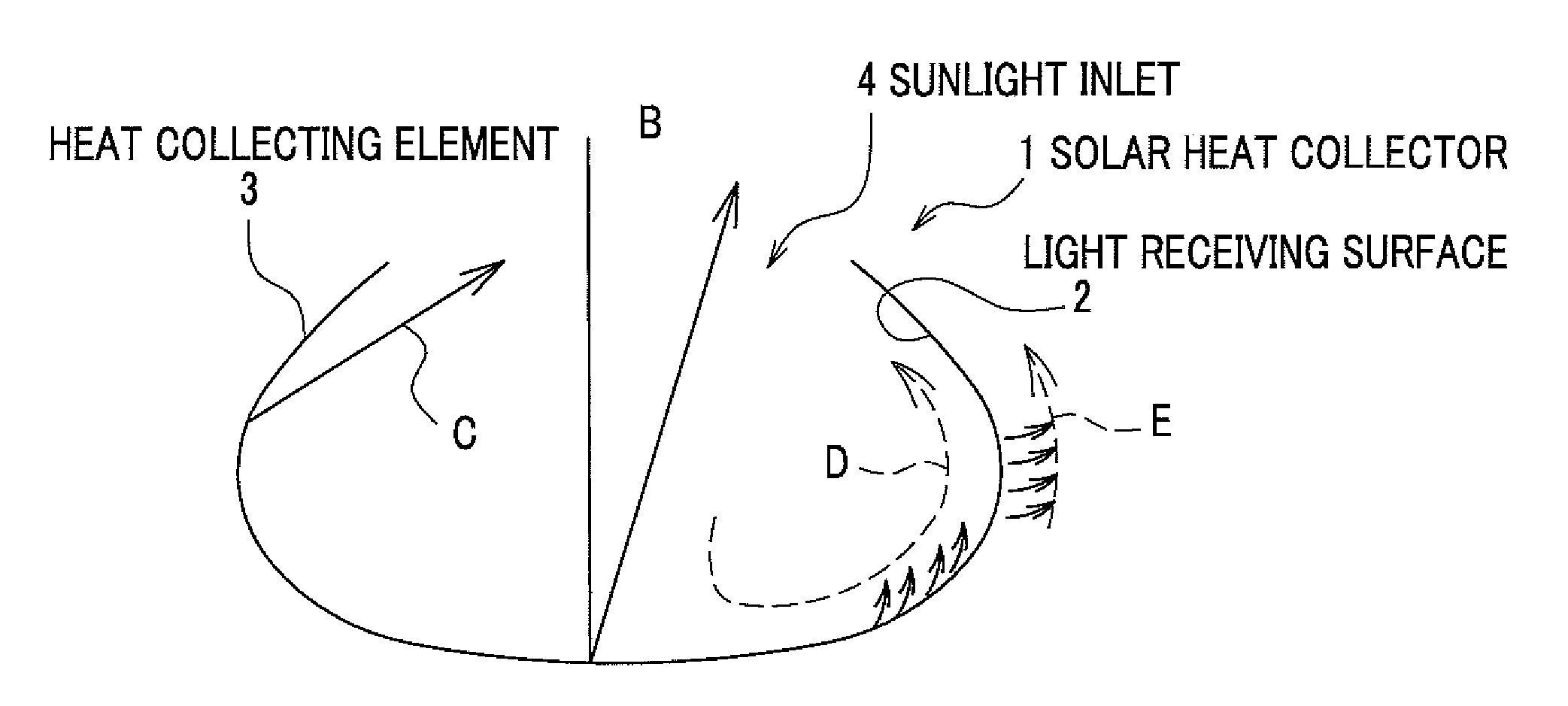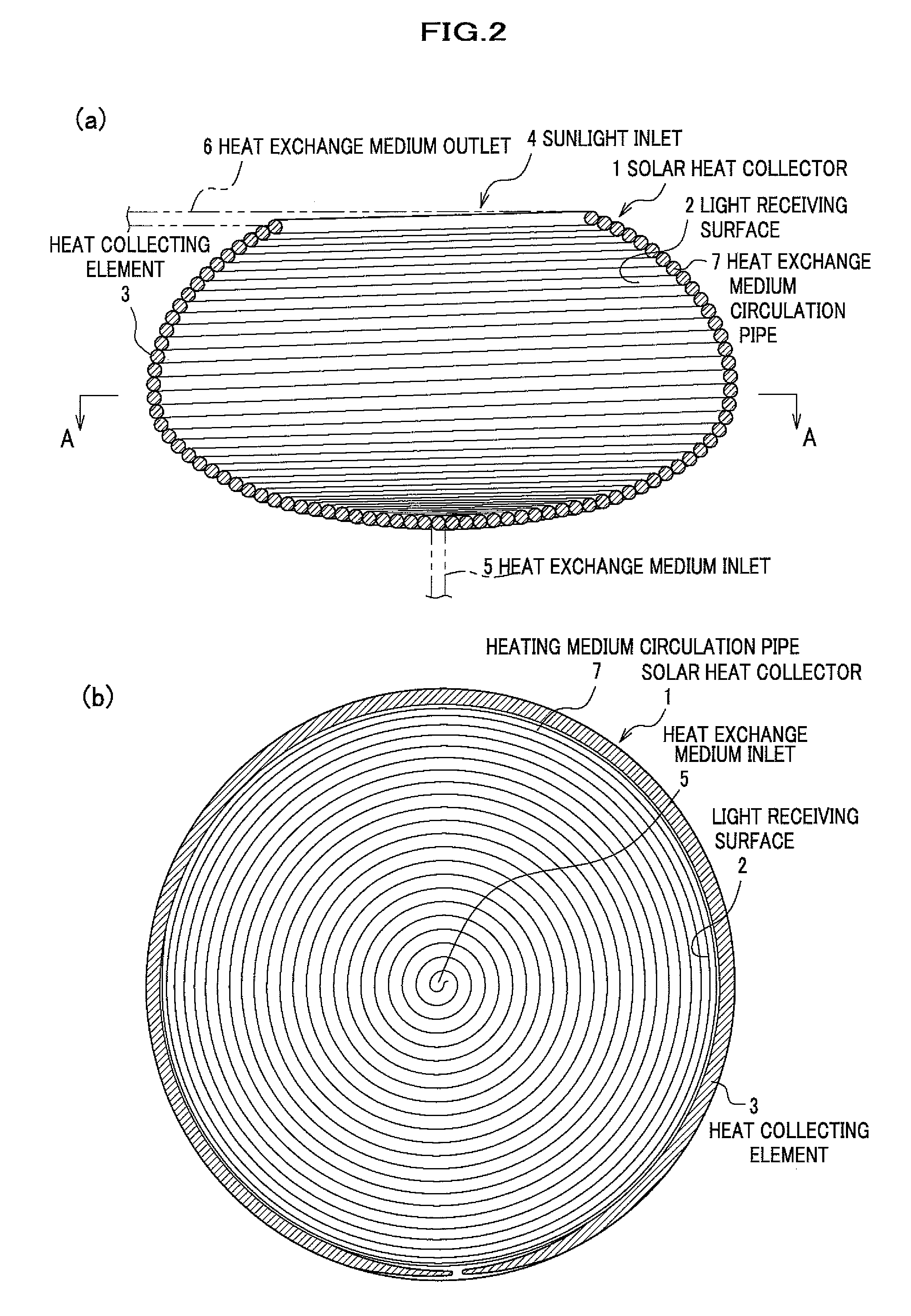Solar Heat Collector, Sunlight Collecting Reflector, Sunlight Collecting System and Solar Energy Utilization System
a solar energy utilization system and solar heat collector technology, applied in the direction of machines/engines, transportation and packaging, light and heating equipment, etc., can solve the problems of difficult to finely control the temperature by flow control, limited sunlight utilization efficiency, and inability to optimize the shape of the heat collector, so as to achieve efficient use of stored thermal energy and efficiently collect sunlight reflected
- Summary
- Abstract
- Description
- Claims
- Application Information
AI Technical Summary
Benefits of technology
Problems solved by technology
Method used
Image
Examples
first embodiment
[0130]FIG. 1 is a schematic diagram showing an example of a solar heat collector according to a first embodiment of the invention.
[0131]The solar heat collector 1 whose outline is shown in FIG. 1 includes a heat collecting element 3, a sunlight inlet 4 which is opened at an end of the heat collecting element 3, a heat exchange medium inlet 5 through which heat exchange medium is introduced into the heat collecting element 3, and a heat exchange medium outlet 6 as shown in FIG. 2(a).
[0132]The heat collecting element 3 is formed by a helically wound circulating heat exchange medium circulation pipe 7 inside which the heat exchange medium flows. Thus, a light receiving surface 2 is constituted of an outer peripheral side of the heat exchange medium circulation pipe 7 which is exposed inside the heat collecting element 3. Then, the light receiving surface 2 is incurved to narrow towards the sunlight inlet 4 which is opened at the end of the heat collecting element 3. The incurved shape ...
second embodiment
[0149]Next, FIG. 8 is a schematic diagram showing an example of a solar energy utilization system according to a second embodiment, which uses the solar heat collector 1 according to the first embodiment of the invention.
[0150]The solar energy utilization system shown in FIG. 8 includes a first light collecting system FC, a second light collecting system SC, a third light collecting system CPC, a solar heat collector 1, a high-temperature heat exchange medium tank 81, a heat exchanger 82, a low-temperature heat exchange medium tank 83, and a heat exchange medium purification system 84. Moreover, the solar heat collector 1, the high-temperature heat exchange medium tank 81, the heat exchanger 82, the low-temperature heat exchange medium tank 83, and the heat exchange medium purification system 84 are connected with each other by flow paths through which heat exchange medium circulates. In addition, valves, and so on are arranged in places.
[0151]A solar heat collector 1 similar to the...
third embodiment
[0157]Next, FIG. 9(a) is a schematic cross section showing a solar heat collector 91 according to a third embodiment of the invention.
[0158]The solar heat collector 91 shown in FIG. 9A includes a heat collecting element 93 whose inner surface constitutes a light receiving surface 92 where heat exchange medium gravitationally flows down as a liquid film, a sunlight inlet 94 which is opened on an upper end of the heat collecting element 93, a heat exchange medium inlet 95 through which the heat exchange medium is introduced into the heat collecting element 93, and a heat exchange medium outlet 96.
[0159]In the heat collecting element 93, thin plates are combined to form the light receiving surface 92 which receives sunlight SB on the inner surface and on which the heat exchange medium gravitationally flows down as a liquid film. Moreover, the light receiving surface 92 is incurved and narrows and converges towards the sunlight inlet 94 which is opened on the upper end of the heat colle...
PUM
 Login to View More
Login to View More Abstract
Description
Claims
Application Information
 Login to View More
Login to View More - R&D
- Intellectual Property
- Life Sciences
- Materials
- Tech Scout
- Unparalleled Data Quality
- Higher Quality Content
- 60% Fewer Hallucinations
Browse by: Latest US Patents, China's latest patents, Technical Efficacy Thesaurus, Application Domain, Technology Topic, Popular Technical Reports.
© 2025 PatSnap. All rights reserved.Legal|Privacy policy|Modern Slavery Act Transparency Statement|Sitemap|About US| Contact US: help@patsnap.com



